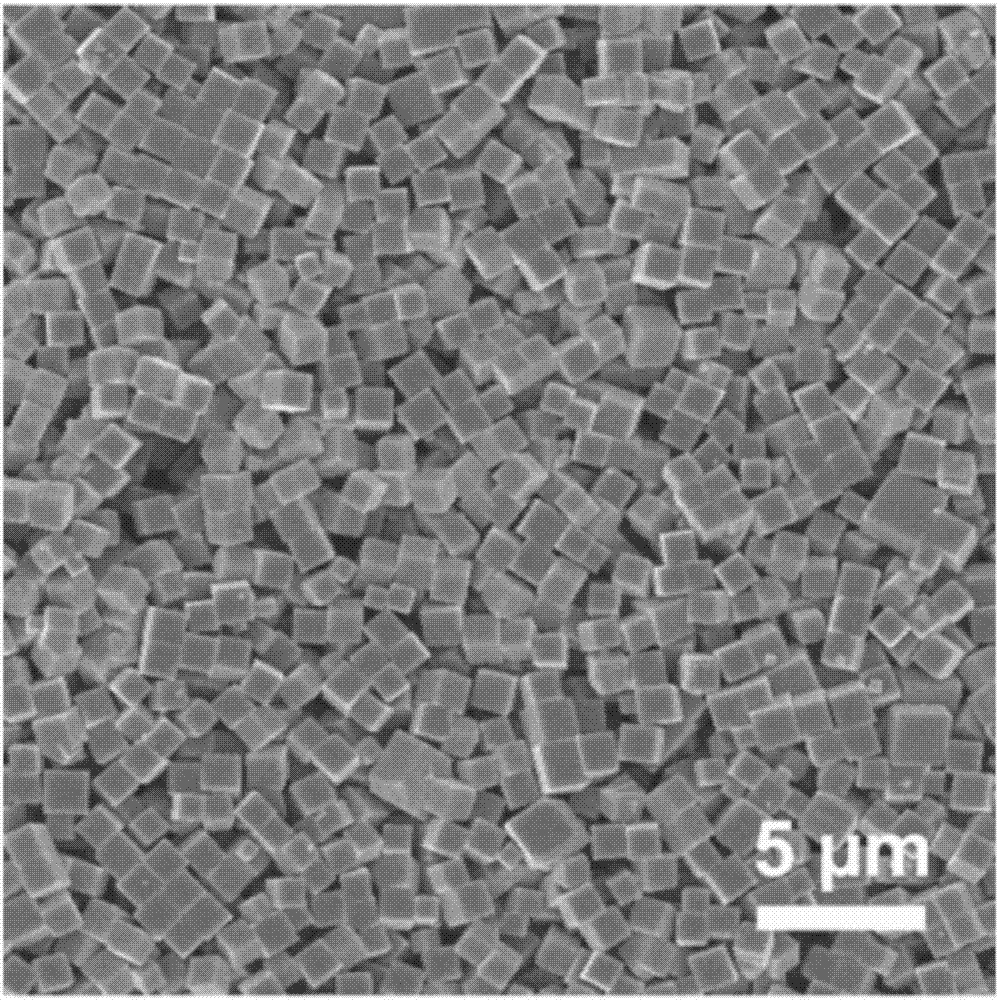Preparation method of hollow ferric oxide cathode material in porous structure
A technology of porous structure and negative electrode material, applied in the direction of iron oxide, iron oxide/iron hydroxide, structural parts, etc., can solve the problems of low theoretical electrochemical capacity, unsatisfactory first discharge efficiency, poor cycle performance, etc., and achieve a simple process. Controllable, beneficial to material rate and cycle performance, and the effect of uniformity assurance
- Summary
- Abstract
- Description
- Claims
- Application Information
AI Technical Summary
Problems solved by technology
Method used
Image
Examples
Embodiment 1
[0024] Weigh 0.1g of potassium ferricyanide and 0.05g of 1,3,5-benzenetricarboxylic acid, put them into a 100mL polytetrafluoroethylene reaction kettle, add 80ml of absolute ethanol, stir well, and adjust the pH value of the solution with 1mol / L hydrogen chloride to 5. After sealing the reaction kettle, keep it warm at 200° C. for 10 h, cool down to room temperature with the furnace, filter the reaction product, wash it 4 times with deionized water, and dry it. Put the dried product into a tube furnace, heat up at a rate of 1°C / min in an air atmosphere, heat at 800°C for 1 hour, and then cool down with the furnace to obtain a hollow cubic iron oxide material. The XRD test shows that the obtained material has high diffraction intensity and is a pure-phase iron oxide negative electrode material, such as figure 1 shown. It can be seen from the scanning electron microscope that the particle size of iron oxide is uniform and the hollow porous structure, such as figure 2 shown. ...
Embodiment 2
[0026] Weigh 0.15g of ferric nitrate and 0.06g of trimesic acid, put them into a 100mL polytetrafluoroethylene reactor, add a mixed solution of 70ml of methanol and 10ml of water, stir evenly, and use 1mol / L ammonia water to adjust the pH value of the solution to 9 . After sealing the reaction kettle, keep it warm at 100°C for 72 hours, cool down to room temperature with the furnace, filter the reaction product, wash it three times with deionized water, and dry it. Put the dried product into a tube furnace, heat up at a rate of 5°C / min in an air atmosphere, heat at 600°C for 2 hours, and then cool with the furnace to obtain a porous iron oxide negative electrode material.
Embodiment 3
[0028] Weigh 0.5 g of ferric sulfate and 0.09 g of 4-pyridinecarboxylic acid, put them into a 100 ml polytetrafluoroethylene reactor, add 80 ml of absolute ethanol, stir well, and adjust the pH value of the solution to 10 with 2 mol / L triethylamine. After sealing the reaction kettle, keep it warm at 130° C. for 10 h, cool down to room temperature with the furnace, filter the reaction product, wash it 4 times with deionized water, and dry it. Put the dried product into a tube furnace, heat up at a rate of 4°C / min in an air atmosphere, heat at 200°C for 0.5h, and then cool with the furnace to obtain an iron oxide negative electrode material.
[0029] image 3 It is the rate performance graph of the iron oxide negative electrode material prepared in Example 3 of the present invention. The electrochemical test results show that compared with the conventional solid-phase method and liquid-phase method, the rate performance of the material is greatly improved. The specific discharg...
PUM
| Property | Measurement | Unit |
|---|---|---|
| electrical resistivity | aaaaa | aaaaa |
Abstract
Description
Claims
Application Information
 Login to View More
Login to View More - R&D
- Intellectual Property
- Life Sciences
- Materials
- Tech Scout
- Unparalleled Data Quality
- Higher Quality Content
- 60% Fewer Hallucinations
Browse by: Latest US Patents, China's latest patents, Technical Efficacy Thesaurus, Application Domain, Technology Topic, Popular Technical Reports.
© 2025 PatSnap. All rights reserved.Legal|Privacy policy|Modern Slavery Act Transparency Statement|Sitemap|About US| Contact US: help@patsnap.com



